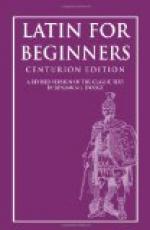The principal parts of the Latin verb are the first person singular of the present indicative, the present infinitive, the first person singular of the perfect indicative, and the perfect passive participle.
184. Conjugation Stems. From the principal parts we get three conjugation stems, from which are formed the entire conjugation. We have already learned about the present stem\, which is found from the present infinitive (cf. Sec. 126.a). The other two stems are the perfect stem\ and the participial stem\.
185. The Perfect Stem. The perfect stem of the verb is formed in various ways, but may always be found by dropping -i: from the first person singular of the perfect, the third of the principal parts. From the perfect stem are formed the following tenses:
THE PERFECT ACTIVE INDICATIVE
THE PLUPERFECT ACTIVE INDICATIVE (ENGLISH
PAST PERFECT)
THE FUTURE PERFECT ACTIVE INDICATIVE
All these tenses express completed action in present, past, or future time respectively.
186. The Endings of the Perfect. The perfect active indicative is inflected by adding the endings of the perfect to the perfect stem. These endings are different from those found in any other tense, and are as follows:
SINGULAR
PLURAL
1. -i:, I 1. -imus,
we
2. -isti:, you 2. -istis,
you
3. -it, he, she, it 3. -e:runt
or -e:re, they
187. Inflection of sum\ in the perfect, pluperfect, and future perfect indicative:
PRES.
INDIC. PRES. INFIN. PERF. INDIC.
PRIN. PARTS sum esse
fui:
PERFECT STEM fu-
PERFECT
SINGULAR PLURAL
fu’i:, I have been, I was
fu’imus, we have been, we were
fuis’ti:, fuis’tis,
you have been, you were
you have been, you were
fu’it, he has been, he was
fue:’runt or fue:’re,
they
have been, they were
PLUPERFECT (TENSE SIGN -era:-) fu’eram, I had been fuera:’mus, we had been fu’era:s, you had been fuera:’tis, you had been fu’erat, he had been fu’erant, they had been
FUTURE PERFECT (TENSE SIGN
-eri-)
fu’ero:, I shall have been
fue’rimus, we shall have been
fu’eris, you will have been
fue’ritis, you will have been
fu’erit, he will have been
fu’erint, they will have been
1. Note carefully the changing accent in the perfect.
2. Observe that the pluperfect may
be formed by adding eram\, the
imperfect of sum\, to the perfect
stem. The tense sign is -era:-.




